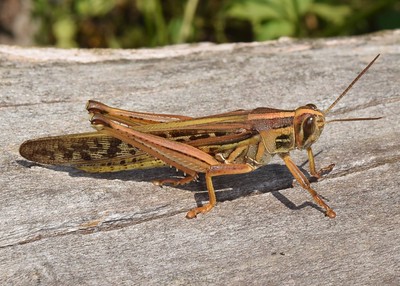Neuroscientists have long sought to explain how the brain correctly recognizes a stimulus despite the stimulus appearing under different circumstances with widely variable external factors. For example, with regard to olfactory stimuli, humans can correctly identify the smell of coffee regardless of location, time of day, ambient conditions (such as temperature and humidity), or other potentially confounding contexts. Researchers term this ability "invariant odor recognition," and when generalized to other senses, "invariant stimulus recognition." A new study now offers insight into invariant odor recognition in locusts. Scientists at Washington University in St. Louis, Missouri, United States, found that a simple arithmetical expression of neuron activations reliably predicted when a locust recognized a particular odor. The findings could improve our general understanding of how olfaction operates in animals and improve the performance of artificial chemical sensing systems, which have a range of applications in environmental monitoring, security, medicine, and other fields. See also: Arithmetic; Chemical senses; Olfaction; Neuron

For the study, the researchers first trained locusts (Schistocerca americana, also known as American bird grasshoppers and in the order Orthoptera) to associate specific odors with a food reward consisting of a blade of grass. After as few as six trials, the locusts learned to expect this food reward when presented with puffs of hexanol (an alcohol) or isoamyl acetate (a plant volatile). As a conditioned reflex, the insects would open their maxillary palps—appendages near their mouths—when presented with the odorant, in a manner similar to dogs salivating upon hearing a bell in famous experiments conducted by Russian physiologist Ivan Pavlov. The researchers then attempted to scramble the locusts' ability to pinpoint the trained odorant stimuli. For instance, the researchers presented confounding odorants simultaneously, presented in both wet and dry conditions and varied exposure time, to the trained odorants. The researchers also examined responses when the locusts were either satiated (fully fed) or starved, as well as trained or untrained. Across these various trials, the insects still reliably identified the hexanol and isoamyl acetate odorants, indicated by the spreading of their palps. See also: Conditioned reflex; Insecta; Learning; Orthoptera
During the experiments, researchers measured the activity of neurons in the insects' antenna lobes, which receive signals from neurons in the antenna when an odorant is sensed. Puzzlingly, the pattern of neuron activations in the lobes proved to be highly variable amongst the locust population, even though the behavioral responses remained consistent. The researchers next employed a machine-learning algorithm to assess this confliction. The algorithm helped in identifying two sets of neurons, dubbed ON and OFF, involved in odorant detection and a resulting response. The ON neurons activated in the presence of an odorant, while the OFF neurons remained inactivated (or "off"). When the odor presentation ended, though, the OFF neurons would activate. The researchers described ON neurons accordingly as conveying evidence for the presence of an odorant, with OFF neurons conversely conveying evidence against the presence of an odorant. Taken together, the number of ON and OFF neuron activations reliably predicted when a locust would react to a presented odorant. Simply adding more ON neuron activations and subtracting greater numbers of OFF neuron activations led to this positive identification and a conditioned reflex response, and vice versa. Overall, the findings point to a simple, arithmetical way to set a threshold for sensation, an insight that could advance the understanding of both natural sensation and artificial sensation for technological applications. See also: Algorithm; Machine learning; Sensation; Sense organ





